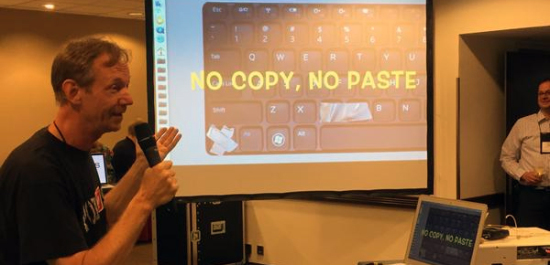
DITA Europe 2014 was held November 18th – 19th in Munich, Germany. The conference was a great opportunity to connect with other DITA users to share our experiences, knowledge and developments in the world of DITA.
Slow but steadily growing DITA usage in Europe
I had the honour of co-presenting this year’s keynote alongside JoAnn Hackos, President of Comtech Services. My portion of the keynote presentation focused on trying to answer the question as to why DITA use in Europe has been relatively slow to take off compared to DITA use in North America.
I plan on writing a post dedicated to this topic in the future, but to summarize I believe low DITA use in Europe boils down to three chief issues:
- The latest DITA 1.2 standard (all 1,200+ pages of it) is in English only, making it fairly inaccessible for non-English readers.
- DITA has been competing against locally-grown standards, such as PI-Mod and Funktiondesign, making the pitch for DITA a harder sell.
- Early adopters of DITA were primarily users in US-based companies, so it took time for the idea of DITA to spread over to Europe.
The DITA Productivity Paradox
JoAnn Hackos concluded the keynote with the results from a study she has been working on that surveys DITA users’ perceptions of their own productivity since adopting DITA. One of the wholly positive results emerging from the survey is that across the board, technical writing teams find that they spend more time planning and structuring their documents, which can only be a good thing when it comes to improving the quality of the content produced.
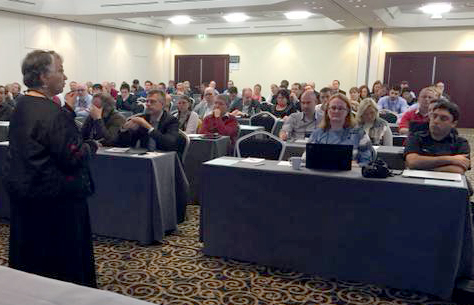
So what is the DITA Productivity Paradox? It is what happens when the longer a firm has been using DITA, the lower its overall productivity gains are when compared to firms that have more recently adopted the standard. When JoAnn examined the productivity of companies that implemented DITA recently versus those that have been using it for five years or more, the latter group showed less overall productivity gains than those that more recently adopted DITA. So what’s going on here?
One theory that came up is that older groups may not be using the latest and greatest tools or taking advantage of DITA 1.2 features; therefore they are not as productive as they could be. I know there’s the adage about not blaming one’s tools, but the fact is that there are many more tools and better-attuned DITA features available now in DITA-optimized editors and modern Component Content Management Systems than there were even a couple of years ago, built for improving productivity with DITA. Along the same lines, I have recently witnessed several veteran DITA-using firms make the switch from the tools/options they’ve been using for years to better DITA-optimized XML editors or CMSes.
I strongly suspect that this may explain much of what JoAnn has seen in her results so far. JoAnn’s research is ongoing so hopefully by the time of CM Strategies/DITA North America in Chicago next April we will know more.
Large-Scale DITA Implementation and User Assistance Innovation at SAP
Dr. Sven Leukert, Vice President of Knowledge Management at SAP and an IXIASOFT DITA CMS customer, also presented at DITA Europe. I was very interested in hearing more about the special challenges of deploying DITA effectively at a very large firm like SAP. Sven presented some interesting stats that I think are worth sharing:
- SAP produces nightly documentation builds, producing over 12,000 document outputs daily
- They currently have over 1.3 million source objects, 80% of which are legacy content from both SAP and companies they have acquired that were already using DITA
- SAP has trained over 300 users on DITA and the IXIASOFT DITA CMS
- SAP started producing DITA-based documentation within six months of their initial implementation, with the full roll out taking about two years.
What made this talk all the more interesting was that through acquisition, SAP not only had in-house DITA expertise, but was also working with a couple of legacy XML-based CMSes prior to choosing the IXIASOFT DITA CMS. This is a trend I have been seeing as of late, where firms using “first-generation” CMSes, some of which are not optimized for use with DITA, are moving on to more modern solutions in a quest to get the most of out their investment with DITA.
One of the main reasons SAP wanted to move to DITA was to provide more innovative solutions in terms of documentation output. As an example of this, Sven pointed the audience to their HTML5-based “Cookbook Business Suite on Hana”. All of the material is DITA-based and provides some food-for-thought as to what is possible.
“No Copy, No Paste” and S1000D to DITA Bridge
Easily the most entertaining “presentation” came at the end of day one during a round of 5-minute lightning talks when Jang Graat presented a video and karaoke-backed parody of Bob Marley’s “No Woman, No Cry” entitled, “No Copy, No Paste”.
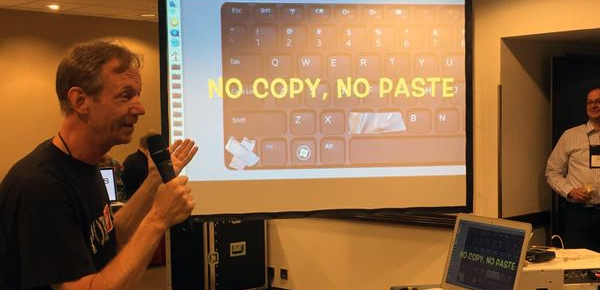
Needless to say, it was a lot of fun, and I suggested that we make it the unofficial anthem for DITA XML. 😉
During this set of lightning talks, Eliot Kimber, Principal Solutions Architect at Contrext Solutions, gave a live demo showing how he could generate a working DITA shell DTD based on his own custom RelaxNG topic specialization, the format that the forthcoming DITA 1.3 standard will be based upon. He not only demonstrated that this is possible, but also made it seem quite easy to do.
I also co-presented a short piece on the S1000D to DITA Bridge, a long-running effort by a number of companies to bring the two XML standards together. S1000D has long been the XML standard of choice used primarily within the aerospace and defence firms, but is not optimal when it comes to documenting software, as some of S1000D’s own experts also agree. That’s where DITA comes to the forefront, and Jean-Jacques Thomasson managed to demonstrate an impressive merging of the XML standards within a single topic, combining features that S1000D users require, while also utilizing the strengths of DITA.
Flowcharts Transmogrified into DITA Tasks
One of the more interesting presentations I attended at DITA Europe was actually a private demo I had with Jang Graat showing off something that he had only talked about at the last DITA North America conference earlier this year in Seattle: a flowchart-based DITA task topic generator.
It was impressive. He had a basic decision flow diagram, like something you might create in MS Visio. The flowchart Jang showed me was not a typical technical writing task, but one that all parents are familiar with: dealing with a crying child. The sample flowchart started with a crying baby. Is she hungry? Give her some food and wait for a response. If she’s still crying, maybe her diaper needs changing? If yes, then change her diaper. End result: a happy baby (hopefully)! Once Jang had all of the parameters for his flowchart in there, all he had to do at the end of the process was touch a button and voila! His flowchart was converted to a DITA task topic. Very impressive!
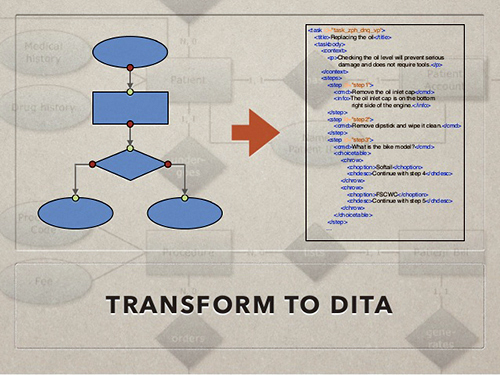
While not all tasks lend themselves to being flowcharted—some tasks do not require choices—having a visual representation to check whether or not you’ve covered all possible permutations would be a great aid to many technical writers (and SMEs) out there.
What I particularly liked about this project is that it illustrates how DITA’s structured nature lends itself to inventive techniques like this, and makes it possible to transform a structured visual representation to structured XML.
I am hoping that Jang will be able to come up with a version of this tool that can “round-trip” DITA task topics back to a flowchart visualization, and that he will make it available in a usable form for DITA technical writers. There’s no solid news on that front available from his website as of yet, but hopefully he will post an update there soon. The slide deck from his presentation at DITA Europe is available on SlideShare.
Why Some Content Management Projects Fail
Joe Pairman from Mekon gave a well-attended talk about why some DITA initiatives fail. I was particularly interested in attending this presentation as Joe had pinged me about the subject about a month before the conference asking for my thoughts since I have also done some research on this topic for the Content Management classes I have taught at the University of Toronto, and so I was curious to hear his take on it.
Joe started off with a classic CMS implementation horror-story, containing all of the following elements, any one of which would normally spell impending disaster:
- Upper management selects a CMS solution without first consulting the people within the company who will actually be using it
- Content-producing teams are not given adequate time to scope their requirements
- The CMS rollout plan is vague on implementation details while being extremely ambitious in terms of deployment scope
- Change management not accounted for
- CMS is bought, but the budget for follow-through (training and other implementation costs) are reduced
- The Project Manager resigns, and the handover process to his/her successor is handled poorly.
Not surprisingly this particular CMS project was a failure, resulting in tens of thousands of wasted hours and expensive penalty clauses invoked by the vendor.
Joe explained through the following dire statistics that CMS implementation failure is not uncommon:
- An IBM survey of 1,500 change management executives found that 59% of projects failed to meet their full objectives
- A KPMG survey of 600 IT project managers reported that nearly 50% had experienced a project failure
- 70% of respondents to a large Dr. Dobbs investigation said that they had been in a project that they knew would fail from the start
Despite the dismal numbers, Joe went on to look at common early warning signs found in many CMS deployment projects which were headed in the wrong direction. He surveyed the work Early Warning Signs of IT Project Failure: The Dominant Dozen by Leon Kappelman and found that many signs of imminent project failure had more to do with people than with tools. Things like “lack of stakeholder involvement”, “no business case for the project” or “no change control process” (ineffective change management), had nothing to do with the software being implemented and everything to do with “people problems”. Thankfully this implies that these types of early warning signs can be acted upon, as people can change and when sufficiently motivated, accomplish much.
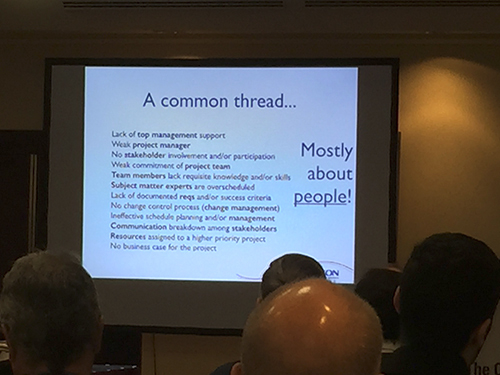
Based on this survey, Joe outlined a 5-step plan to spot early warning signs of impending CMS failure, and how to overcome them:
- Acknowledge that there is a real problem
- Properly audit and manage project requirements and expectations
- Build a new plan
- Get buy-in from upper management for the new plan
- Follow the new plan, monitor progress and further adapt things as required
Joe concluded with another case study of a firm with an impending CMS failure, this time for a software company trying to implement a DITA-based CMS. During project implementation, the company reorganized and the new team didn’t understand the point of moving to DITA and only saw the complexity of the system rather than the benefits it could bring in process efficiency. Admitting that there was a problem, the company took corrective action – in this case hiring someone with DITA experience. This person’s knowledge was shared with the new stakeholders and a new content strategy was agreed upon. As a result, the reorganized team was slowly won over and their attitude became positive as they saw the benefits of change. And so a DITA-based CMS project that was heading for failure became a success instead.
My favourite takeaway from the presentation was this line from the IBM study, Making Change Work, on what makes for successful organizational change: “better communications and employee involvement enable and empower people, then change happens through them – not just to them”. Joe’s presentation demonstrated that CMS deployment projects that face significant problems need not fail so long as the needs and problems of the people who are working with the system are acknowledged and dealt with properly.
Celebrating with Champagne
A highlight of the second day was when several bottles of Champagne were uncorked alongside the IXIASOFT booth by our CEO Eric Bergeron, courtesy of DITA Europe attendee Marie-Louise Flacke. Marie-Louise hails from the Champagne region in France and she has made it a tradition to generously share some of her region’s namesake drink with other attendees at the conclusion of DITA Europe. It was a great way to round out the conference!

The next CIDM conference in North America was officially announced at DITA Europe: Content Management Strategies/DITA North America conference, taking place in Chicago and scheduled for April 27-29, 2015. With any luck my conference proposal will be accepted so I hope to see you there!
This article was originally published in two parts on the IXIASOFT website (Part 1 and Part 2), and its contents are reproduced here with permission.

Interesting post. Thanks for writing up your takeaways. I find the point about analyzing why DITA implementations fail to be interesting. Why do we never seem to blame the tech, but rather put the blame on people and processes? It seems to me that a 1,200+ page DITA spec might share some of the blame for the failures. Doc solutions shouldn’t be so difficult to make successful. Just my thoughts.
I think that is a fair point, though that’s something that didn’t come up during his talk–though I *did* mention it as a barrier for why Europe has not embraced DITA in the same way that North America has.
One of the key takeaways for me from Pairman’s talk was how much of the failures relied upon people-related issues, not the tech. Having said that, I don’t doubt that it also plays a role, but again at the more personal level.
So yes the DITA 1.2 is over-long and not written with tech writers in mind; so if any tech writer is supposed to read it and “get” DITA without any training for a launch, I’d say the fault is more with management being too stingy with their training budget. So the unwieldy spec may be part of the problem (and I am pleased to say that the DITA 1.3 spec is shorter and has more useful examples) but we need to focus on the human element more.
Hi Keith,
thanks for that great post.
Just a small detail: Your link to the Cookbook Business Suite on Hana is broken (should not be local).
Chris
Thanks for pointing that out! It was due to a missing “http://” before the URL. Now fixed!